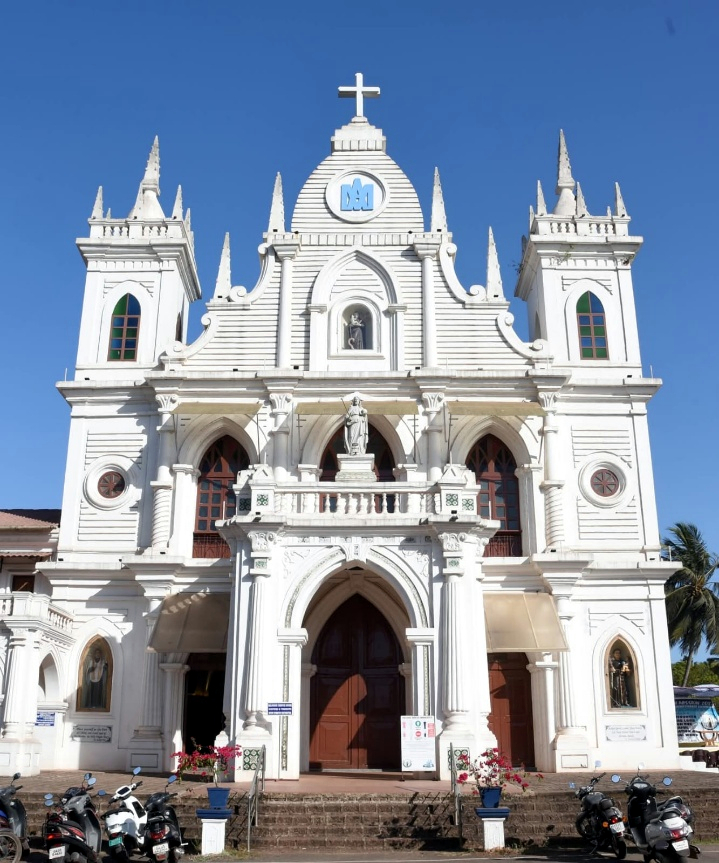
CHRONICLES OF CHURCHES IN GOA
The magnificent Church at Marna, Siolim is dedicated to St Anthony of Padua. Though the feast is on June 13, the parishioners celebrate it on the following Sunday and this year, it falls on June 15.
THE ORIGIN
The Franciscans established the first Church at Gaunsavaddo in Siolim in 1568 and dedicated it to Mae de Deus, the Mother of God. Being a mud structure, it lasted for just 32 years. In remembrance of this church, a Monument was erected in 1900 in the shape of a Pillar with a Cross on it and on it were inscribed words in Portuguese, which when translated read thus: ‘here existed the first church founded by the Franciscans in 1568.’
The Franciscans wanted to construct a larger church in a location more central to Christian locality, hence they began to look out for a new place. They found a suitable spot in Marna village at the edge of the Chapora river. The foundation stone for it was laid in 1600. When the work was in progress, they fell short of funds. At this time two Portuguese merchants helped them with funds.
How this happened has a story behind it.
Two Portuguese merchants while sailing from Portugal to Goa, encountered a storm in the Arabian sea. They were carrying a big statue of St Anthony on the ship which was meant for Old Goa. At this difficult moment, they prayed to the saint for their safety and vowed to erect a church in his honour at the closest point when they touched the land.
The storm abated and they were guided to the Fonde Poim along the Chapora River, where they met the Franciscan fathers who were in the process of building a church and in need of funds. The merchants donated huge amounts to the fathers for the construction of the church, and also gave them the statue of Saint Anthony.
When the work on the Church was in progress, a huge serpent of frightful dimension began to terrify the workmen and Fr Brass dos Anjos, who was directing the work. Frustrated with the menace of the terrible serpent, the priest decided to abandon the work and choose another spot for the church, far away from the present one.
Before taking the final decision, they went to the statue of St Anthony, which was installed in a niche in the half complete Capela Mor and prayed fervently to solve their problem. Early next morning, to their great surprise, they saw the snake ensnared in a rope dangling in the saint’s hand. Hence, Mae de Deus was displaced to make place for Saint Antony. To commemorate this miracle, a picture was painted of St Anthony holding the serpent tied with a cord in his right hand and a cross in his left hand.
The present Church
The foundation for the present church at the same sight was laid on November 15, 1902 and it was blessed on December 28, 1907. In front of the church is a pulpit and so too a huge monument of Christ the King; it was blessed on December 31, 1930 by auxiliary bishop patriarch, Dom Manuel.
The Church bell was brought from Germany and on it is painted the image of St. Anthony and the names of the donors. Down the years, the church has been renovated.
The Church’s architecture is neo-gothic; it has a narthex, broad nave and chancel, with attached residence. On the front façade of the church is the statue of the saint; it has two towers which have circular windows in the middle level and each is surmounted by pointed dome, balustrades and finials.
The church has five altars. The beautifully and artistically engraved teak wood main altar is dedicated to St Anthony, who is shown with a serpent of silver tied with silver chain. The second altar is dedicated to Guia Saibinn, the third to St Sebastian. The altar in front of the pulpit is dedicated to the Sacred Heart of Jesus and the fifth altar near the door opposite the baptismal font is dedicated to Our Lady of Safe Delivery.